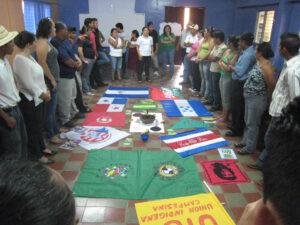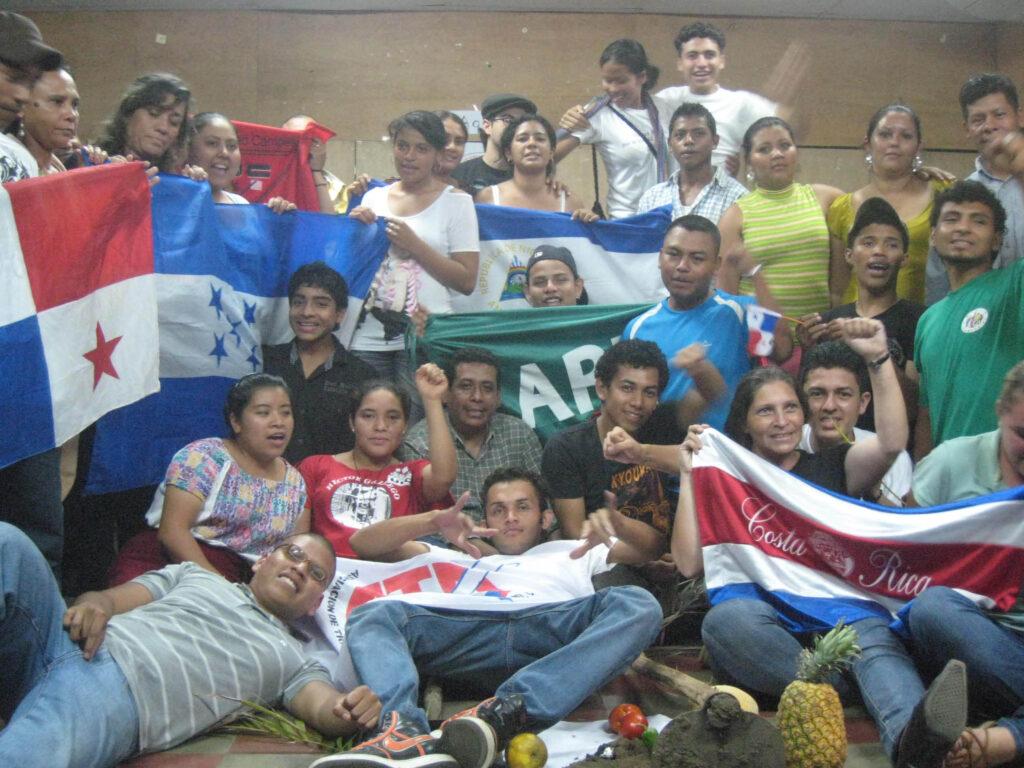Central American Peasant School Teaches Us Lessons
This blog is part of a series that Grassroots International’s Latin America Program Coordinator, Saulo Araújo, will be posting during his site visit to Central America. Through the “Field Notes” blogs, Saulo will share contextual analysis and information from partners and allies.
This morning, I write from La Via Campesina’s Central American Peasant School, located on the outskirts of Managua, Nicaragua. Grassroots International grants helped build and support the school, enabling peasants from around the region to participate in trainings there.
As I type my notes, three facilitators in their mid-20s fire up the room with chants about struggle and peasant power. From my seat in the back, I count 27 participants. There are Mayan representatives from Guatemala, young peasants from Panamá, and women from Honduras, Costa Rica and Nicaragua. Many traveled a significant distance over difficult terrain to reach the school for this week-long leadership training. The room exudes excitement and purposefulness.

In the center of the auditorium, a mosaic of flags from different countries, La Via Campesina and other member organizations forms a kind of sanctuary. I also see rice and bean seeds, representing the “pinto de gallo,” a staple food in Nicaragua. The arrangement is part of the “mística,” a popular education technique that aims to represent each participant as well as the collective.
Via Campesina is a global social movement of farmers, fishers, other small producers, including indigenous communities in over 70 countries. In Central America, the Via currently has 31 member organizations, including several of Grassroots’ partners and allies such as the National Coordination of Peasants and Indigenous People (CONIC) from Guatemala and Nicaragua’s Association of Rural Workers (ATC). Through trainings like this, the Via endeavors to create a strong foundation of new leaders who will continue the struggle for peasant rights in Central America for years to come.
The Via Campesina’s goals are ambitious and urgent: Ending hunger and exploitation by empowering peasants and indigenous people to defend their rights to land, water and food sovereignty. And to defend the democratic distribution of resources and social justice, the Via Campesina supports agrarian reform that will address the claim of land poor or landless peasant families and women’s rights to land, water, seeds, and food. As an ally of the Via, Grassroots International contributes to this process by building links of solidarity and commitment between people in the United States and organizations in the Global South like the Via Campesina.
Are we achieving our goals? Yes, we are. Through the training school, thousands of peasants and indigenous people, adult and young, gather to share their experiences and learn from one another. Currently, the school accommodates 50 “students” comfortably, including mothers, the elderly and those who had never left home before, like Cirilo Martinez, a shy young man from Panamá, who says, “It is my first time here, and the first time I left Panamá.”
Cirilo is only 25 but is already president of a farmers’ association and, along with his father, mother, and siblings, a member of the Panamanian Peasant Union (UCP), a Via member. “My father is more of a behind-the-scenes organizer,” Cirilo say, “He helped to create UCP 11 years ago, so he was happy that I was coming to this training.”
History Lessons
Father-to-son, mother-to-daughter, generation-to-generation, the classes in the school include topics such as agrarian reform, food sovereignty, gender and women’s rights, indigenous rights, communication strategies and, of course, leadership. Sitting here in a room with a new generation of leaders I hear personal stories and learn the broader history of the peasant movement in Central America.
“In my country, agrarian reform was often seen as communist ideology. Nobody wanted to speak about that for fear of being seen as a communist,” said one participant.
Fausto Torrez, a seasoned organizer who serves as technical advisor for Via Campesina’s Global Campaign for Agrarian Reform, offers an alternative lesson about agrarian reform. “Actually, agrarian reform was conceived initially as a capitalist idea. It was planned to transform the peasant families into entrepreneurs within a capitalist framework,” reports Fausto. But for the Via, agrarian reform is about justice and rights for peasants and other small producers, who still feed the majority of people around the world, yet make up the majority of the world’s hungry.
Oliverio, a youth organizer from the Mayan Youth Movement (MOJOMAYAS) shares that indigenous people in his home country of Guatemala are either landless or living in areas where the soil is depleted or no longer appropriate for agricultural purposes. As matter of a fact, Guatemala has the highest rate of landlessness in Central America. According to a document prepared by ActionAid and the Peasant Unity Committee (CUC), approximately 54 percent of Guatemala’s agricultural land is controlled by 1.98 percent of the population.
Oliverio’s words spark a robust conversation, and after him a string of others speak on the topic. One of them, a member of the Peasant and Indigenous Union of Panamá, denounces the growing problem of land grabbing. “In Panama,” this member reports, “landowners control the best farmland, the most flat and fertile land in the countryside.”
An experienced facilitator, Fausto diverts the conversation by asking his Nicaraguan countrymen the question, “Is there agrarian reform in Nicaragua?” Silence fills the room as the group seems divided about the outcome. Many peasant families in Nicaragua still do not have land title. In a way, the answer is, “Yes, and no.”
The diverse political affiliations in the room add another interesting aspect. More than half of the participants are supportive of the Sandinista Front for National Liberation (FSLN). The rest are members of organizations affiliated to the opposition. Despite their political differences, they work together towards the same goals of peasants rights to land, water and food.
The building of an effective social movement for food sovereignty

One of its many accomplishments is that the Via Campesina brings together peasants, indigenous peoples, pastoralists, and fishers who share a strong political view oriented towards social justice and system change. By making political education of its members a priority, the Via Campesina can mobilize and re-energize rural families whose political views are often ignored. Using popular education methods, the organization is able to create a safe (and empowering) space for the leadership development of peasants, women and youth.
After this week-long training is over, participants will organize workshops in their countries of origin. The “repase” or sharing workshops will help the organization reach out to a larger group. Using a farmer-to-farmer methodology, Via Campesina’s leadership trainings help build a strong foundation and larger movement by reaching out to thousands of others who were not able to join us in Nicaragua.
With great sacrifice, peasants in Central America teach us by example. They demonstrate that a world without hunger is possible, and that they—peasants, indigenous people, women and youth—have the solutions, through a different paradigm that combines protecting the commons from privatization, international solidarity and respect for the rights of Mother Earth. This is the life lesson from peasants that we often ignore. But hopefully, we will soon begin to learn the lessons that they are teaching. After all, they are more than a billion people whose resources and labor feed all the five plus billion inhabitants of our shared planet.
